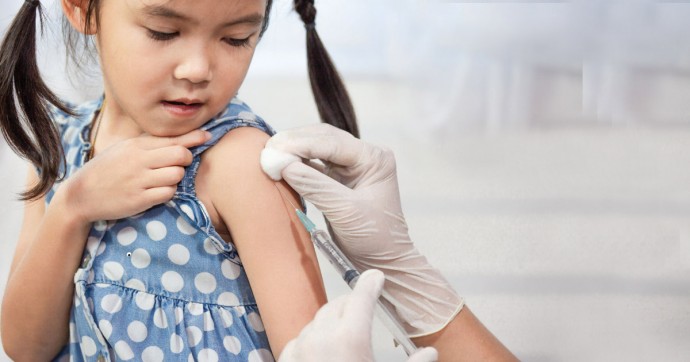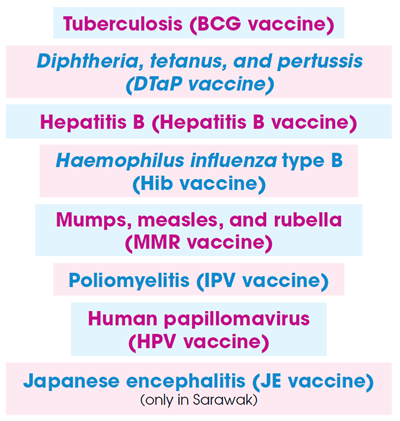You might be aware of the importance of vaccination and know that you have to give vaccines to your child starting from birth. However, how familiar are you with the vaccines given to your child?
In Malaysia, the National Immunisation Programme (NIP) was introduced in the early 1950s and designed based on the World Health Organisation (WHO) Expanded Programme on Immunisation (EPI). While the EPI recommends that all countries immunise against 6 childhood diseases, our NIP has gone further and expanded protection against 12 major childhood diseases. These diseases and the respective vaccines are as follows, and the schedule for receiving them can be referred from your child’s paediatrician:
What is a vaccine?
So, what are vaccines? Basically, a vaccine is a biological preparation that boosts our immunity to a specific disease. A vaccine usually contains an agent that is similar to microbes causing the diseases. The agent is often made from weakened or killed forms of the microbe, its toxins, or one of its components. The body’s immune system will be stimulated by the agent, which will then be identified as a foreign substance. The immune system, like the army of a kingdom, will then proceed to destroy the foreign invaders that have attacked the body. The immune system will also ‘remember’ it for future encounters, so that it is easier for the system to identify and destroy any of these microorganisms.
Types of vaccine
There are several different types of vaccine, depending on the form of agent that is used to produce it.
Live, attenuated vaccines: This type of vaccine is made from a form of the living microbe that can’t cause diseases since it has been weakened in the lab. A live, attenuated vaccine is a good ‘teacher’ of the immune system because it is the closest to natural infection. It can stimulate strong cellular and antibody responses and often grants lifelong immunity with only one or two doses. Examples of live, attenuated vaccine are the BCG vaccine against tuberculosis, and the MMR vaccine against mumps, measles and rubella.
Inactivated vaccines: Disease-causing microbes are killed using heat, chemicals, or radiation to create inactivated vaccines. Compared to live vaccines, inactivated vaccines are safer and more stable. However, they might stimulate a weaker immune response than live vaccines; several additional doses or booster shots might be needed to retain a person’s immunity. For example, injectable vaccines against polio and pertussis are inactivated vaccines.
Subunit vaccines: In subunit vaccines, only essential antigens that stimulate the immune system are included. The chances of adverse reactions are lower in this type of vaccine because it contains only the necessary antigens and excludes other molecules. The vaccine against hepatitis B is an example of a recombinant subunit vaccine.
Toxoid vaccines: When illnesses are caused by specific toxins produced by bacteria, toxoid vaccines are typically used. It was found that toxins can be inactivated by treating them with formalin, a solution of formaldehyde and sterilized water. These inactivated toxins are called toxoids. Diphtheria and tetanus are examples of illnesses that can be prevented using toxoid vaccines.
Conjugate vaccines: Some bacteria species have an outer coating of sugar molecules called polysaccharides. These polysaccharide coatings can disguise antigens contained in bacteria, causing the immature immune systems of infants and younger children unable to identify or react to them. To solve this problem, conjugate vaccines, a special type of subunit vaccine, can be made by linking the polysaccharides with antigens or toxoids that are recognizable by the infant’s immune system. The vaccine that protects against Haemophilus influenzae type B (Hib) is a conjugate vaccine. So is the pneumococcal conjugate vaccine.
Methods of vaccination
There are also different methods of vaccination. Vaccines can be given as a single vaccination, simultaneous vaccination, or as combination vaccines. Single vaccination means that one specific vaccine is given during one session, while simultaneous vaccination means that several different vaccines are given in separate shots during one session. For example, BCG and hepatitis B vaccines are given simultaneously during the very first vaccination session. Combination vaccines, on the other hand, are several different vaccines that are combined in one shot, such as MMR and DTaP vaccines. One of the latest combination vaccines is the 6-in-1 vaccine that protects against six diseases, which are diphtheria, tetanus, pertussis, polio, Hib, and hepatitis B. In the early period of infancy, vaccines are usually given simultaneously to ensure earlier protection from diseases for babies. Combination vaccines are also given to save on cost as there will be fewer trips to the doctor, and reduce the number of shots, which will be less painful for the child.
Did you know?
There are also optional or other recommended vaccines apart from the mandatory ones included in the NIP. These vaccines are pneumococcal, meningococcal, rotavirus, varicella (chicken pox), and hepatitis A vaccines. They are available in private hospitals and clinics, and can be given to your child to expand the protection against respective diseases. To find out more about other recommended vaccines, you can refer to our collection of articles on mypositiveparenting.org.
Vaccines are one of the greatest inventions in human medical history. Since the introduction of smallpox vaccine by Edward Jenner in 1796, more vaccines have been developed, more diseases have been prevented or eradicated, and more lives have been saved. There are no reasons to not vaccinate your child, and there is no doubt that vaccines are beneficial for our health and wellbeing today.
An educational contribution by Malaysian Paediatric Association.








Comments